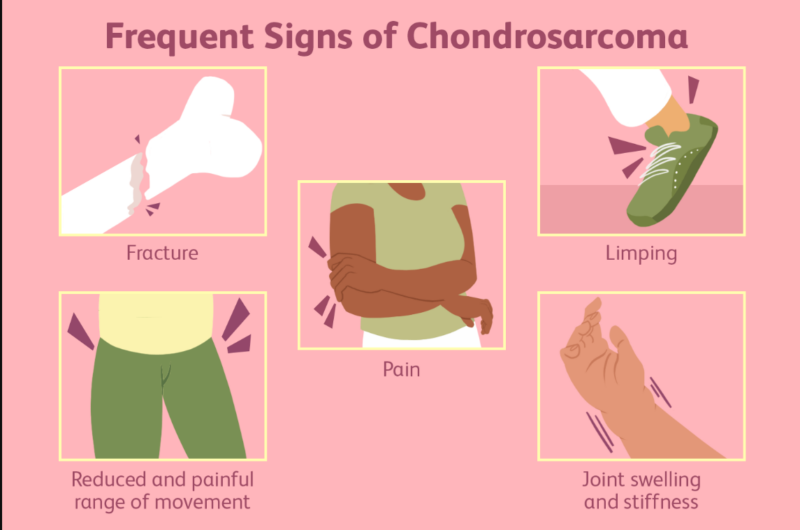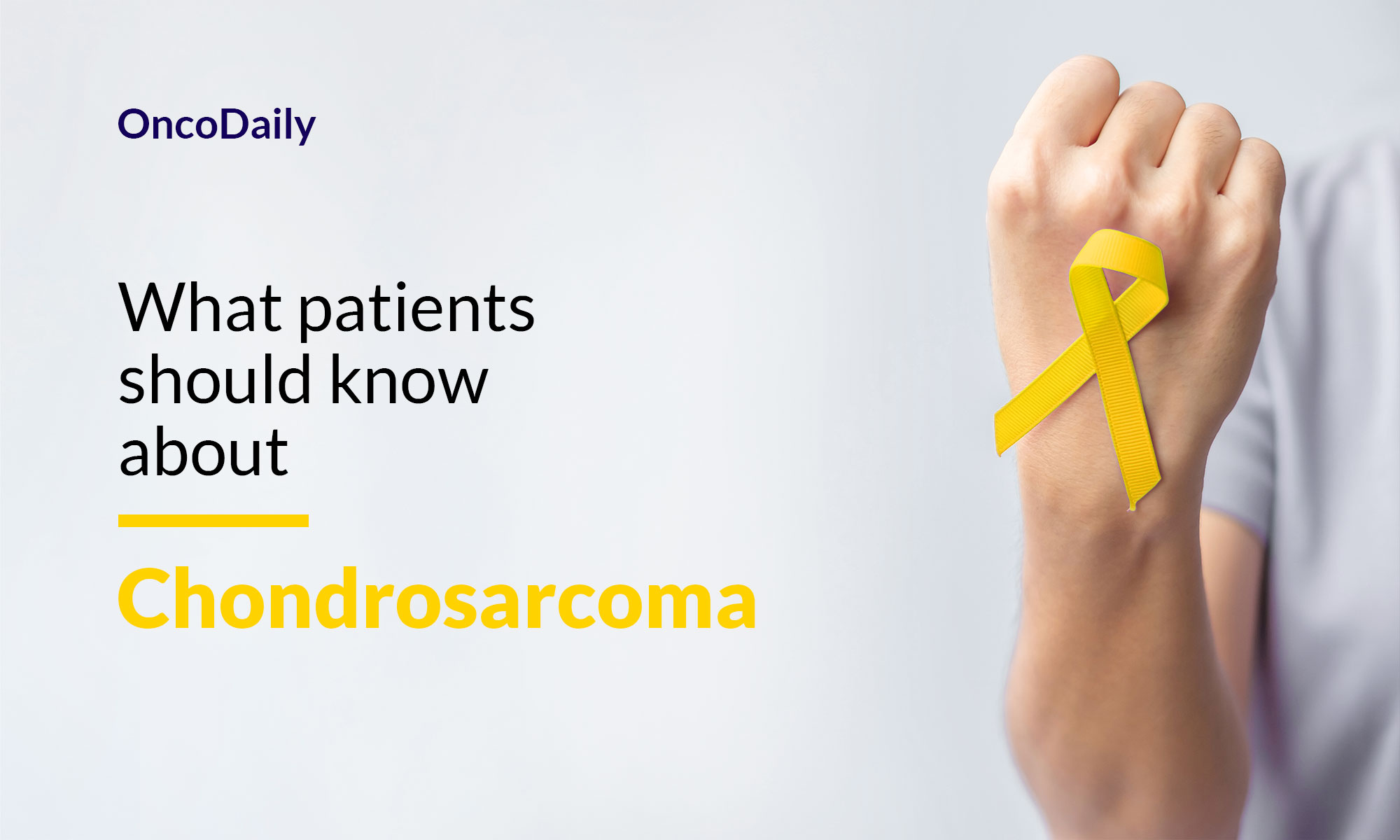Introduction, what is chondrosarcoma?
Chondrosarcoma is a rare type of cancer that typically begins in the bones but can also occur in the soft tissue near bones. It is a malignant tumor that develops from cartilage cells, which are the specialized, gristly connective tissues present in adults. This type of cancer is the second most common primary bone cancer, accounting for about 20-30% of all bone sarcomas. Chondrosarcoma most often affects adults between the ages of 40 and 70, although it can occur at any age.
This informative video is taken from VJOncology
Causes and Risk Factors
The exact cause of chondrosarcoma is not well understood. However, several risk factors have been identified that may increase the likelihood of developing this type of cancer:
- Age: Chondrosarcoma is more common in middle-aged and older adults.
- Genetic Conditions: Certain inherited conditions, such as Ollier disease and Maffucci syndrome, which cause benign bone growth, can increase the risk of chondrosarcoma.
- Previous Radiation Therapy: Exposure to high doses of radiation, often used to treat other cancers, can increase the risk of developing chondrosarcoma later in life.
- Benign Bone Tumors: Conditions like enchondromas and multiple exostoses (osteochondromas) can sometimes transform into chondrosarcoma.
Symptoms
Chondrosarcoma symptoms can vary depending on the location and size of the tumor. Here are some common symptoms along with the reasons why they occur:
Pain: One of the most common symptoms of chondrosarcoma is pain. This pain is typically deep, dull, and aching. It tends to worsen gradually over time and can become quite severe. Patients often notice that the pain is more intense at night, which can disrupt sleep.
Unlike some other types of pain, this discomfort may not be relieved by rest or common pain relievers like anti-inflammatory medications. The pain is usually localized to the area where the tumor is growing, such as the pelvis, thigh, or shoulder. This pain arises because the tumor is growing within the bone or cartilage, causing pressure and irritation to the surrounding tissues and nerves.
Swelling and Lump: Another noticeable symptom is swelling or the presence of a lump in the affected area. This lump can be felt under the skin and may be tender to the touch. The swelling is due to the tumor growing and pushing against surrounding tissues.
In some cases, the lump may be visible, especially if the tumor is located near the surface of the body. This can be particularly concerning for patients as it is a visible sign that something is wrong. The lump forms because the tumor is expanding, causing the bone or cartilage to bulge outward.
Limited Movement: If the tumor is located near a joint, it can significantly restrict movement and impair joint function. For example, a chondrosarcoma in the hip or knee can make walking difficult and painful. Patients may notice stiffness and a reduced range of motion in the affected joint.
This limitation can interfere with daily activities and reduce the overall quality of life. Simple tasks like bending, lifting, or even sitting for extended periods can become challenging. This symptom occurs because the tumor’s growth can physically block or restrict the normal movement of the joint, and the pain associated with the tumor can make movement uncomfortable.
Nerve Compression: Chondrosarcomas that grow near nerves can cause additional symptoms due to nerve compression. For instance, a tumor in the pelvis can press on nerves that run down the legs, leading to symptoms such as numbness, tingling, or weakness in the legs. This can affect the ability to walk or stand for long periods.
In severe cases, nerve compression can lead to problems with bowel or bladder control, which can be distressing and require immediate medical attention. These symptoms arise because the growing tumor exerts pressure on the nerves, disrupting their normal function and causing these neurological symptoms.
Other Symptoms
In addition to the primary symptoms mentioned above, patients with chondrosarcoma may experience other signs depending on the tumor’s location and size. These can include:
- Fatigue: Persistent tiredness and lack of energy, which can be due to the body’s response to the cancer.
- Weight Loss: Unintended weight loss can occur as the body uses more energy to fight the tumor.
- Fever: Some patients may experience low-grade fevers as part of the body’s immune response to the cancer.

This image is taken from verywellhealth.com
When to Seek Medical Attention
It is crucial for patients to seek medical attention if they experience any of the symptoms mentioned above, especially if the symptoms persist or worsen over time. Early diagnosis and treatment can significantly improve the prognosis and quality of life for individuals with chondrosarcoma. If a patient notices a persistent lump, unexplained pain, or any signs of nerve compression, they should consult a healthcare provider promptly.
Diagnosis
Diagnosing chondrosarcoma involves several steps:
- Physical Examination: A thorough physical exam to check for signs and symptoms.
- Imaging Tests: X-rays, MRI, CT scans, and bone scans are used to visualize the tumor and assess its size, location, and impact on surrounding tissues.
- Biopsy: A sample of the tumor tissue is taken and examined under a microscope to confirm the diagnosis and determine the grade of the cancer.
Prevention
There are no specific measures to prevent chondrosarcoma, especially since the exact cause is unknown. However, early detection and monitoring of benign bone conditions that could potentially transform into chondrosarcoma can be beneficial. Regular check-ups and imaging tests for individuals with known risk factors, such as genetic conditions or previous radiation therapy, may help in early diagnosis and treatment.
Prognosis
The prognosis for chondrosarcoma depends on several factors, including the grade of the tumor, its location, and whether it has spread to other parts of the body. Generally, low-grade tumors have a better prognosis and are less likely to spread, while high-grade tumors are more aggressive and have a higher risk of metastasis.
Treatment and Side Effects
The primary treatment for chondrosarcoma is surgery to remove the tumor. The type of surgery depends on the tumor’s size and location. Here is a detailed look at the various treatment options and their potential side effects, explained in a patient-friendly manner.
Surgery
Surgery is the main treatment for most types of chondrosarcoma. The goal is to remove the tumor completely, which can be challenging depending on its size and location. There are different surgical approaches:
Limb-Sparing Surgery
Limb-sparing surgery involves removing the tumor while preserving the limb. This type of surgery is often followed by reconstruction using bone grafts or prosthetics to replace the removed bone and tissue. The aim is to maintain as much function and appearance of the limb as possible. This surgery can be complex and may require a team of specialists, including orthopedic surgeons and plastic surgeons.
Side Effects:
- Pain and Swelling: Post-surgery pain and swelling are common and can be managed with pain relief medications.
- Infection: There is a risk of infection at the surgical site, which can be treated with antibiotics.
- Limited Mobility: Initially, there may be limited movement in the affected limb, which can improve with physical therapy.
- Nerve Damage: In some cases, nerves may be affected during surgery, leading to numbness or weakness.
Amputation
In severe cases, where the tumor cannot be removed without affecting the limb’s function, amputation may be necessary. This involves removing all or part of the limb with the tumor. Amputation is usually considered when the tumor has grown into the nerves or blood vessels, or if it is very large.
Side Effects:
- Phantom Limb Pain: Some patients may experience pain that feels like it is coming from the limb that was removed.
- Infection: As with any surgery, there is a risk of infection at the site of amputation.
- Prosthetic Use: Most people who have an amputation will use an artificial limb (prosthesis) after surgery. Learning to use a prosthesis can take time and may require physical therapy.
Reconstructive Surgery
Reconstructive surgery is often done at the same time as the surgery to remove the tumor. This can involve bone and tissue grafts to replace tissues removed during surgery. An endoprosthesis may be used to replace joints removed with surgery.
Side Effects:
- Pain and Swelling: Similar to other surgeries, pain and swelling are common and can be managed with medications.
- Infection: There is a risk of infection, which can be treated with antibiotics.
- Limited Mobility: Initially, there may be limited movement, which can improve with physical therapy.
- Rejection of Grafts: In some cases, the body may reject the bone or tissue grafts, requiring additional treatment.
Radiation Therapy
Radiation therapy uses high-energy rays to destroy cancer cells. It is often used when the tumor cannot be completely removed by surgery or to control the spread of the cancer. Radiation therapy can also be used for recurrent chondrosarcoma or for tumors located in difficult-to-operate areas like the base of the skull or spine.
Side Effects:
- Skin Irritation: The skin in the treated area may become red, sore, or irritated, similar to a sunburn.
- Fatigue: Many patients feel very tired during and after radiation therapy. This fatigue can last for several weeks after treatment ends.
- Nausea and Diarrhea: Radiation to the abdomen or pelvis can cause nausea, diarrhea, and urinary problems.
- Long-Term Effects: Radiation can sometimes cause long-term side effects, such as damage to nearby organs or tissues, which may lead to issues like dry mouth, difficulty swallowing, or joint stiffness.
Chemotherapy
Chemotherapy uses drugs to kill cancer cells. However, it is generally not effective for most types of chondrosarcoma. Chemotherapy may be used for certain aggressive subtypes like mesenchymal and dedifferentiated chondrosarcomas, which are more likely to respond to these drugs.
Side Effects:
- Nausea and Vomiting: Chemotherapy can cause nausea and vomiting, which can often be managed with anti-nausea medications.
- Hair Loss: Many chemotherapy drugs cause hair loss, which is usually temporary.
- Fatigue: Chemotherapy can lead to significant fatigue, making it difficult to carry out daily activities.
- Increased Risk of Infection: Chemotherapy can lower the number of white blood cells, making it easier to get infections.
- Anemia: A decrease in red blood cells can cause anemia, leading to fatigue and shortness of breath.
Newest Options and Ongoing Trials
Research is ongoing to find new and more effective treatments for chondrosarcoma. Some of the promising areas of research include:
- Targeted Therapy: Drugs that specifically target genetic mutations found in chondrosarcoma cells, such as IDH1 and IDH2* inhibitors.
- Immunotherapy: Treatments that boost the body’s immune system to fight cancer cells.
*IDH1 and IDH2 mutations play an important role in the development and progression of chondrosarcoma.
More information about ongoing clinical trials can be found on clinicaltrials.gov
Patient Survivorship
Surviving chondrosarcoma can bring its own set of challenges. Long-term follow-up care is essential to monitor for recurrence and manage any ongoing health issues. Survivors may face physical challenges, such as limited mobility or the need for prosthetics, and emotional challenges, including anxiety and depression. Support groups, physical therapy, and counseling can be valuable resources for survivors as they navigate life after cancer.
This fascinating video is taken from the Cleveland Clinic
Resources
- American Cancer Society – cancer.org
- National Cancer Institute – cancer.gov
- Biology and Management of High-Grade Chondrosarcoma
- Novel Therapeutic Approaches in Chondrosarcoma
- Dedifferentiated Chondrosarcoma from Molecular Pathology to Current Treatment and Clinical Trials
- Chondrosarcoma: A Clinical Review
- Treatment method and prognostic factors of chondrosarcoma
- Survival and prognostic factors in conventional central chondrosarcoma
- Risk Factors for Incidence and Prognosis in Chondrosarcoma Patients with Pulmonary Metastasis at Initial Diagnosis
- Presenting features and overall survival of chondrosarcoma of the pelvis
- Sixty Percent 10-year Survival of Patients With Chondrosarcoma After Local Recurrence
- Chondrosarcoma – StatPearls
